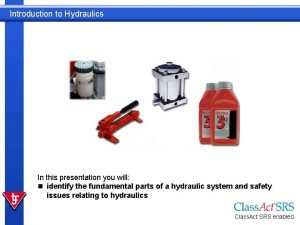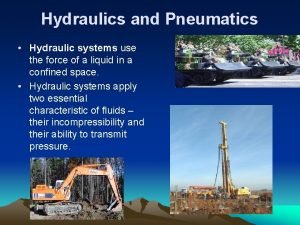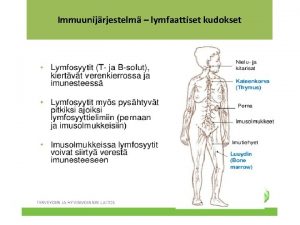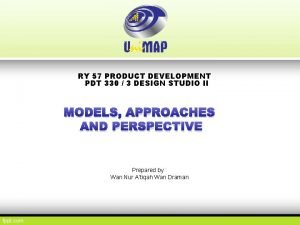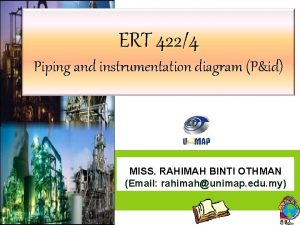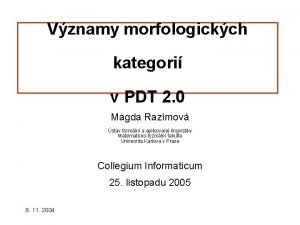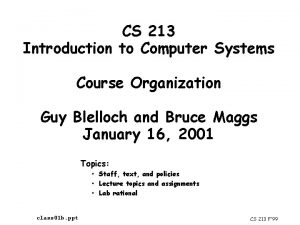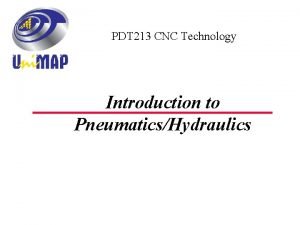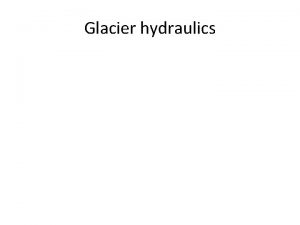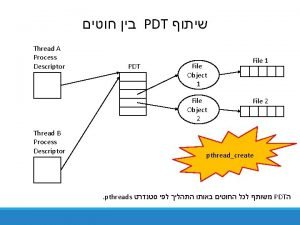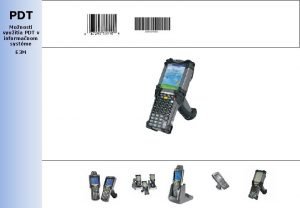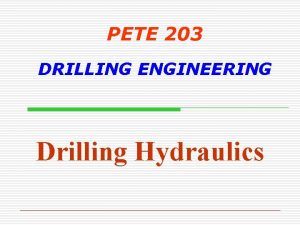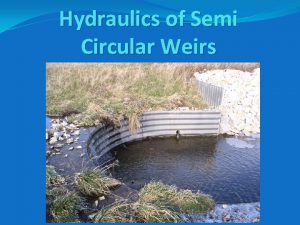PDT 213 CNC Technology Introduction to Hydraulics System



















- Slides: 19

PDT 213 CNC Technology Introduction to Hydraulics System

Introduction to Hydraulics • Fluid power is the method of using pressurized fluid to transmit energy. • Liquid or Gas is referred to as a fluid. Accordingly, there are two branches of fluid power; Pneumatics, and Hydraulics. • Hydraulic systems use liquid to transfer force from one point to another. • Pneumatic systems use air to transfer force from one point to another.

Introduction to Hydraulics • Air is Compressible: (This describes whether it is possible to force an object into a smaller space than it normally occupies. For example, a sponge is compressible because it can be squeezed into a smaller size). • Liquid is Incompressible: (The opposite to compressible. When a “squeezing” force is applied to an object, it does not change to a smaller size. Liquid, for example hydraulic fluid, possesses this physical property).

• Hydraulic systems - used pressurized incompressible liquids as transmission media • Works on the principle of Pascal’s law which says that the pressure in an enclosed fluid is uniform in all the directions. 4

Schematic Diagram of Hydraulic System 5

Common examples of hydraulic systems include: Hydraulic jack • In a hydraulic jack, a small piston (pumping piston) transmits pressure through the oil to a large piston (power piston) through a check valve, resulting in the weight being lifted as shown in Fig. 1. 3. (a) Hydraulic jack (b) Hydraulic jack schematic diagram

Basic Component of Hydraulics System § § § Movable piston Storage tank Filter Hydraulic pump Pressure regulator Control valve 7

Hydraulic system components • Power input device: The pump and motor together are called the power input device; the pump provides power to the hydraulic system by pumping oil from the reservoir/tank. The pump’s shaft is rotated by an external force which is most often an electric motor.

Hydraulic system components • Control device: Valves control the direction, pressure, and flow of the hydraulic fluid from the pump to the actuator/cylinder. • Power output device: The hydraulic power is converted to mechanical power inside the power output device. The output device can be either a cylinder which produces linear motion or a motor which produces rotary motion. • Liquid: the liquid is the medium used in hydraulic systems to transmit power. The liquid is typically oil, and it is stored in a tank or reservoir. • Conductors: The conductors are the pipes or hoses needed to transmit the oil between the hydraulic components.

Hydraulic power pack • The hydraulic power pack combines the pump, the motor, and the tank. The hydraulic power pack unit provides the energy required for the hydraulic system. The parts of the hydraulic power pack unit. The main parts of the hydraulic power pack

Fundamental laws of Hydraulics • All hydraulic systems operate following a defined relationship between area, force and pressure. • Laws have been established to explain the behavior of hydraulic systems. • Hydraulic systems use the ability of a fluid to distribute an applied force to a desired location.

Pressure Where Force is in newtons (N) and Area is in square meters (m 2). 1 Pascal (Pa) =1 N/m 2. 1 bar= 100, 000 Pa= 105 Pa. 10 bar= 1 MPa (mega Pascals)

Pascal’s Law • Pascal’s law states that: “The pressure in a confined fluid is transmitted equally to the whole surface of its container” • When force F is exerted on area A on an enclosed liquid, pressure P is produced. The same pressure applies at every point of the closed system Pascal’s law.

Liquid flow Flow rate versus flow velocity • The flow rate is the volume of fluid that moves through the system in a given period of time. • Flow rates determine the speed at which the output device (e. g. , a cylinder) will operate. • The flow velocity of a fluid is the distance the fluid travels in a given period of time. • These two quantities are often confused, so care should be taken to note the distinction. The following equation relates the flow rate and flow velocity of a liquid to the size (area) of the conductors (pipe, tube or hose) through which it flows. Q=V x A Where: Q= flow rate ( m³ /s ) V= flow velocity (m / s ) A= area (m² )

Liquid flow Example 1 A fluid flows at a velocity of 2 m/s through a pipe with a diameter of 0. 2 m. Determine the flow rate. Solution: 1. Calculate the pipe area 2. Calculate the flow rate

The continuity equation Hydraulic systems commonly have a pump that produces a constant flow rate. If we assume that the fluid is incompressible (oil), this situation is referred to as steady flow. This simply means that whatever volume of fluid flows through one section of the system must also flow through any other section. Figure below shows a system where flow is constant and the diameter varies Fig. 1. 12: Continuity of flow.

The continuity equation The following equation applies in this system: Therefore, The following example illustrates the significance of the continuity equation shown above.

Example 2 Determine the working pressure, P and hydraulic liquid flow rate, Q for a cylinder with 150 mm piston diameter to move a work piece for 250 mm in 15 s. 50 k. N is required to move the work piece. Formula • Force, F • P=F/A • P = fluid pressure • A = cross sectional area Velocity, v • Q = v. A • Q = pump displacement x rpm • Q = fluid flow rate A = πd 2/4 = 0. 0177 m 2 P = F / A = 50000 / 0. 0177 = 2. 8 Mpa v = 0. 250 / 15 = 0. 01667 ms-1 Q = v. A = 0. 01667 (0. 0177) = 2. 95 x 10 -4 m 3/s 18

Comparison of Hydraulics and Pneumatics Hydraulics System Pneumatic System It employs a pressurized liquid as a fluid. It employs a compressed gas, usually air, as a fluid An oil hydraulic system operates at pressures up to 700 bar. A pneumatic system usually operates at 5– 10 bar. Generally designed as closed system. Usually designed as open system. The system slows down when leakage occurs. Leakage does not affect the system much. Pumps are used to provide pressurized liquids. Compressors are used to provide compressed gases. Automatic lubrication is provided. Special arrangements for lubrication are needed. Heavier in weight Lighter in weight 19
 Introduction to hydraulics and pneumatics
Introduction to hydraulics and pneumatics Introduction to hydraulics and pneumatics
Introduction to hydraulics and pneumatics Khotbah gerry takaria
Khotbah gerry takaria Prorphyrin
Prorphyrin Rotavirusripuli aikuisella
Rotavirusripuli aikuisella En 14351-1
En 14351-1 Pdt anwar tjen
Pdt anwar tjen Pdt product development
Pdt product development P&id hic
P&id hic Aga pdt
Aga pdt Pdt manufacturing
Pdt manufacturing 2 pdt
2 pdt Pdt anwar tjen
Pdt anwar tjen 2 pdt
2 pdt Contchap
Contchap Pdt alex
Pdt alex Dos cosas te he demandado letra
Dos cosas te he demandado letra Rumah sungai lenggong perak
Rumah sungai lenggong perak 15-213 introduction to computer systems
15-213 introduction to computer systems 15-213 introduction to computer systems
15-213 introduction to computer systems
